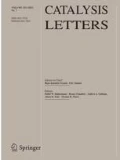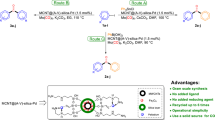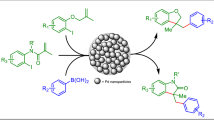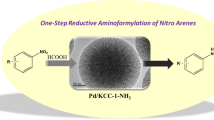Abstract
In this study, we synthesized a robust and sustainable Pd/SiO2 nanospheres catalyst. Further, its catalytic activity was demonstrated for the direct reductive coupling of nitroarenes under mild conditions. While the reaction with Pd nanoparticles on other supporting materials such as modified carbon materials and TiO2, under similar conditions, resulted formation of amines exclusively. Therefore, it was confirmed that the SiO2 was found to be the best supporting material towards the selective reductive coupling of nitroarenes. Also, the catalyst could be recycled up to five cycles with a marginal loss of product yield (< 2% yield).
Graphic Abstract

Similar content being viewed by others
1 Introduction
Aromatic azo and azoxy compounds are vital and valuable ingredients for the synthesis of organic dyes, pigments, food additives, indicators, optical storage media, therapeutic agents and other drug derivatives [1,2,3]. Direct reductive coupling of nitroarenes is a challenging task to produce azo and azoxy aromatic compounds with controlled selectivity (without forming amines) at ambient temperature [3]. In general, industrially the azo and azoxy compounds are synthesized by diazotization (i.e. the coupling of diazonium salts with electron-rich aromatic compounds) [2]. This process is tedious and unfriendly with the environment, due to the formation of unstable diazo compounds as waste and harsh process condition is used in this conversion [2, 4]. In a green approach, azo compounds can be acquired via aerobic oxidation of amines by heterogeneous catalysis, however, this process requires a high amount of supported noble metal catalysts or expensive oxidants, which constrains broad-scale applications [5, 6].
Heterogeneous catalysis demonstrates incredible potential in driving essential organic reactions (i.e. C–C couplings, reduction and oxidation reactions, etc.) and the innovation has along these lines pulled in significant consideration in the most recent decades [7,8,9,10,11,12,13,14]. The recent development of silica-supported metal nanoparticles has further boosted the fundamental research and industrial potential of heterogeneous catalysis, as these inexpensive and eco-friendly materials show the reasonable catalytic performance and stability, under mild conditions [15, 16]. Silica has a wide range surface area with broad applications in every field especially in catalysis. Also, silica-supported heterogeneous catalysts are more beneficial over traditional homogenous catalysts as they limit the ecological impact of organic transformations to a great extent [17]. Silica supported metal nanoparticles has some additional advantages over other heterogeneous solid supports. Because, modification of silica surface with organic, inorganic moieties and metal nanoparticles is relatively easy due to the presence of surface silanol groups (polar functional moiety) [18]. Also, having a huge surface area, which provides a large number of active sites. In addition, silica has good physicochemical properties and is inert under the reaction progression. Moreover, silica has tunable pore structures [19]. Therefore, based on the above reasons, silica is considered as the best solid support for the organic transformations.
Recently, a number of studies have been reported for the formation of aniline, azoxy and azo compounds via heterogeneous catalysis using supported metal nanoparticles shown in Table 1 [20,21,22,23,24,25,26,27,28,29,30,31,32]. The heterogeneous catalysts, such as, Pd [20, 23], Pd–Pt [21], and Rh [22] nanoparticles on various supporters such as PVP–iron powder, g-C3N4, Fe3O4 and SiO2 coated Fe3O4, proved to be effective in producing quantitative yields of anilines and without the formation of self-coupled products [20,21,22,23]. Whereas, Au, Pt and Co nanoparticles supported by CeO2, TiO2, ZrO2 and Mg–Al hydrotalcite nano-structures, generated, exclusively the reductive self-coupled product instead of aniline [24,25,26,27,28,29,30,31,32]. In this study, for the first time, we describe Pd nanoparticles supported SiO2 for direct reductive self-coupling of nitroarenes.

2 Results and Discussion
2.1 Synthesis of SiO2 Nanospheres
In a typical synthesis of SiO2 nanospheres, initially, 200 mL of EtOH and 50 mL of water (4:1) were taken in a 500 mL round bottom flask on a magnetic stirrer. In addition, 4.5 mL of NH4OH was added dropwise and immediately 12.9 mL of tetraethylorthosilicate (TEOS) was added and stirred for 4 h at room temperature. Finally, the SiO2 nanospheres were collected by centrifugation and washed with ethanol and water. The formed wet material was dried under a hot air oven at 60 °C.
2.2 Synthesis of Pd/SiO2 Nanospheres
Initially, 84 mg of PdCl2 was dispersed in 20 mL of EtOH in a separate vessel and stirred for 30 min. In another vessel, 500 mg of SiO2 nanospheres were dispersed in 30 mL of EtOH and added PdCl2 solution dropwise at room temperature and stirred on the magnetic stirrer. After 1 h, 0.5 mL of N2H4·H2O was added to the stirred solution and then after 15 min the temperature increased from room temperature to 70 °C and stirred 12 h. Finally, the formed material was collected by filtration washing with ethanol and water. The resultant Pd/SiO2 nanospheres were dried under vacuum oven for overnight. Figure 1 represents the diagrammatic representation of Pd/SiO2 nanospheres synthesis.
2.3 Characterization of the Catalyst
2.3.1 XRD Analysis
The phase, crystalline nature and structural confirmation of as-prepared Pd/SiO2 nanospheres were attained by powder X-ray diffraction (PXRD) studies. The PXRD pattern of Pd/SiO2 shown in Fig. 2. The Pd nanoparticles showed the corresponding d-spacing values are 2.244 Å, 1.943 Å, 1.374 Å, 1.173 Å and 1.121 Å. These d-spacing values can be attributed to (111), (200), (220), (311) and (222) lattice planes of Pd (JCPDS No. 46-1043). The broad amorphous peak at 10°–35° indicates the presence of SiO2 [35]. From the XRD data analysis, it was found that the Pd nanoparticles were dispersed/impregnated on the surface of the SiO2.
2.3.2 FTIR Spectrum Analysis
The FTIR spectra of SiO2 nanospheres and Pd on SiO2 nanospheres were scheduled in the range of 660–4000 cm−1 and the spectral data shown in Fig. 3. In SiO2 nanospheres, the observable peaks were attributed at 3704.8 cm−1, 1514.0 cm−1, 1059.3 cm−1, 940.3 cm−1 and 787.4 cm−1. The band due to adsorbed water shows an asymmetric broadband range from 3540 to 3660 cm−1. This band attribute with the moisture water which exists everywhere around us [36]. Moisture on SiO2 nanospheres is mainly trapped as Si–OH by breaking the bonds in the network of SiO2 nanospheres [37, 38]. Therefore, the resultant stretching frequency of –OH band in Si–OH observed a sharp peak at 3704.8 cm−1 and the bending mode of –OH band in Si–OH could be seen at around 1630 cm−1 but which was hindered by many stretching peaks of Si–O [38]. The broad peaks can be seen between the ranges of 1400 and 1800 cm−1 which indicates the stretching bands of Si–O [38]. The main and highest intense band SiO2 nanospheres assigned at 1059.3 cm−1, which indicates the antisymmetric stretching frequency of Si–O–Si bond [39,40,41]. Whereas, symmetric stretching frequency of Si–O–Si bond observed at 787.4 cm−1 [40]. A weakly bonded silanols (Si–OH) on the SiO2 nanospheres surface observed the vibrational band at 940.3 cm−1 [39]. When Pd nanoparticles were dispersed on the surface of SiO2 nanospheres, the highest intense Si–O–Si and Si–OH peaks shifted to lower frequency side i.e., 1050.8 cm−1 and 936.5 cm−1 respectively [39]. The shifting of Si–O–Si and Si–OH bands indicates that Pd nanoparticles were strongly adsorbed on the surface of the SiO2 nanospheres [39].
2.3.3 XPS Analysis
To further analyze the oxidation state and bonding between the atoms and quantifications of the elements in the catalyst were characterized by X-ray photoelectron spectroscopy (XPS). The wide scan XPS spectra of Pd/SiO2 and the elements Pd 3d, Si 2p, O 1s core-level spectra’s are shown in Fig. 4. In Fig. 4, the characteristic peaks 3d3/2 and 3d5/2 were showed at 335.4 eV and 342.4 eV and these peaks assigned to Pd (0) and the new peak at 347.9 eV is a plasmon loss associated with the peak 335.4 eV [42, 43]. Moreover, the core level spectra of Si 2p showed the binding energies at 107.6 eV, 109.0 eV and 110.2 eV respectively. These peaks accounted for the unique chemical state of Si atom (Si4+ from SiO2) [44]. The oxygen atoms surrounded by the Si atom in SiO2 nanospheres which supplies a certain density to the Si atom. Therefore, the local position of the Si 2p shifted to higher binding energy side [44,45,46]. At the same time, Si 2s core-level spectra also shifted to higher binding energy side i.e., 158.8 eV and 160.3 eV. The O 1s core-level spectrum showed the three components of binding energy at 538.9 eV, 539.7 eV and 540.4 eV which indicates the oxygen atoms surrounded by the Si atom [44]. Also, C 1s peak attributed at 289.3 eV and 291.6 eV which indicates the carbon atom surrounded by oxygen atoms [44].
2.3.4 SEM Analysis
The FE-SEM images of Pd/SiO2 nanospheres were shown in Fig. 5. From Pd/SiO2 nanospheres SEM images, we demonstrate that the morphology of SiO2 is a smooth spherical in shape. Moreover, Fig. 5 reveals that the Pd nanoparticles are distributed on the surface of SiO2 nanospheres. Also, some of the Pd nanoparticles are agglomerated. From SEM images of Pd/SiO2 nanospheres, the average of spherical size in SiO2 is 410.5 nm. Whereas, the Pd nanoparticles average particles is approximately 8.3 nm.
2.3.5 TEM Analysis
To further confirmation of morphology and particle size of SiO2 and palladium, we investigated with transmission electron microscopy (TEM) shown in Fig. 6. In this TEM analysis, we observed the morphology of SiO2 is a soft spherical in shape and the average particle size of each spherical is 410 nm. Whereas, the Pd nanoparticles size is 7.5 nm. These TEM results support with the SEM results.
2.4 Catalytic Performance
To find out the optimal reaction conditions, the reactions were screened for the direct reductive self-coupling of nitroarenes 1a (1 mmol) in the presence of various catalysts. The results are summarized in Table 2. Thus, initially, the reaction of nitrobenzene 1a was performed with hydrazine monohydrate as a reductant in the presence of catalyst Pd/GO and ethanol as solvent at room temperature for 12 h. However, aniline was formed as the product, in 72% yield instead of reductive coupled product 3/4 (Table 2, entry 1). Similar results were noted with Pd–Au/TiO2 catalyst (Table 2, entry 2). Also, the reaction under neat reaction conditions with hydrazine monohydrate and with various catalysts (Pd/GO, Pd–Au/TiO2, Pd/TiO2, Au/TiO2, Pd/activated charcoal and Pd/SiO2 nanospheres), furnished the aniline 2a (Table 2, entries 3 to 8). Even when water was used as the solvent, gave aniline 2a, as an exclusive product in the presence of Pd–Au/TiO2 (Table 2, entry 9). The same results were observed by using NaBH4 as the reducing agent and water as a solvent for 12 h (Table 2, entry 10). Notably, with the Pd/SiO2 nanospheres catalyst, NaBH4 as a reductant and in water, direct reductive self-coupling of nitrobenzene to the azoxybenzene 3a (84%) was noticed along with the formation of aniline 2a as a minor product (Table 2, entry 11). While the reaction in water and ethanol (1:1) mixture, with the same catalyst and reductant, gave 78% yield of azoxybenzene 3a (Table 2, entry 12). Interestingly, when ethanol was used as the sole solvent, isolated 3a in 92% (Table 2, entry 13). On the other hand, at 80 °C, the yield of 3a was decreased to 75% and without appreciable formation of aniline 2a (Table 2, entry 14). No progress was noted in the absence of palladium catalyst and with SiO2 nanospheres, even for prolonged reaction time (Table 2, entry 15).

2.5 Effect of NaBH4 Concentration
In addition, we optimization study was screened with regards to the equivalents of NaBH4. From Fig. 7, when increasing the number of equivalents of NaBH4 (1 to 5 equiv), the formation of by-product aniline 2a was decreased and the yield of azoxybenzene 3a was increased. When 1, 2, 3.5 and 5 equivalent of NaBH4 was employed along with Pd/SiO2 nanospheres and ethanol, the % of yields ratio of aniline 2a and azoxybenzene 3a are 33:35, 25:48, 20:56 and 5:92, respectively. From these results, it was concluded that 5 equiv of NaBH4 is the optimized amount for the direct hydrogenative coupling of nitroarenes to form azoxybenzene 3a.
With these optimized conditions in hand (Table 2, entry 13), we amplified the scope of the reaction and explored with various substituted nitroarenes 1a–q, for the formation of hydrogenative coupled azoxybenzene products. The reaction was quite smooth and furnished the azoxybenzenes 3. The process showed broad functional group tolerance, for example, the reaction was amenable to nitrobenzenes having functional groups (H, Me, Br, Cl, F, NH2, CH2OH) and afforded the corresponding azoxybenzenes [3a (92%), 3b (73%), 3c (94%), 3j (20%) and 3m (83%)] (Table 3). Particularly, the reaction was found to show excellent selectivity and tolerance with Br, Cl and F functionalities present the benzene ring of 1 [3d (65%), 3e (86%), 3f (88%), 3g (92%), 3h (48%) and 3i (52%)] (Table 3). The low yield in case of 3j may be attributed to slow reaction rate due to the presence of a strong electron-donating amino group of 1m. While nitrobenzaldehydes 1k–m, furnished azoxybenzenes/azobenzenes and with relatively higher reaction rates. In addition, the aldehyde group also was reduced, which is usual in the presence of NaBH4. This may be due to the electron-withdrawing ability of aldehyde moiety. The protocol was also successful with 4-acylnitrobenzene 1o, exclusively afford secondary alcohol azobenzene 3o, in 90% yield. On similar grounds, para-nitrobenzoyl chloride 1p generated exclusively 4m. The substrate nitrocinnamic acid ester 1q was also found amenable and furnished a mixture of azoxy-/azo-cinnamic acid esters 3q/4q.
2.6 Recyclability Test
To check the sustainability of catalyst retains its activity, recyclability was also tested. Catalyst recovered by using centrifugation, ethanol washing, treatment with water and acetone and drying (vacuum oven at 60C for overnight) steps. Thus, the recovered Pd/SiO2 nanospheres catalyst was then subjected to the next catalytic cycles. The recovered catalyst was found to be active without an appreciable reduction in the product 3f yield, under the established conditions. Thus, based on the above results it was confirmed that the Pd/SiO2 nanospheres catalyst is having enough stability and can be reused (Fig. 8).
2.7 Mechanism
The plausible reaction pathway for the conversion of nitrobenzene 1a into azoxybenzene 3a and azobenzene 4a is shown in Fig. 9. Initially, the adsorbed nitrobenzene 1a on the metal surface would undergo partial reduction via a two-hydride ion transfer and furnish nitrosobenzene A and N-phenyl hydroxylamine B. The nitrosobenzene A and N-phenyl hydroxylamine B would combine and afford azoxybenzene 3a (step I, Fig. 9). Reduction of azoxybenzene 3a gives azobenzene 4a (step II, Fig. 9). Further, azobenzene 4a would reduce to produce aniline 2a (step III, Fig. 9).
3 Conclusion
We have developed highly efficient and sustainable heterogeneous Pd/SiO2 nanospheres for the direct hydrogenative coupling of nitroarenes environmentally benign conditions. The reaction proceeded at mild conditions and showed broad functional group tolerance. The catalyst was robust and recyclable.
References
Ferlin F, Cappelletti M, Vivani R, Pica M, Piermatti O, Vaccaro L (2019) Au@zirconium-phosphonate nanoparticles as an effective catalytic system for the chemoselective and switchable reduction of nitroarenes. Green Chem 21:614
Hu L, Cao X, Shi L, Qi F, Guo Z, Lu J, Gu H (2011) A highly active nano-palladium catalyst for the preparation of aromatic azos under mild conditions. Org Lett 13:5640
Dai Y, Li C, Shen Y, Lim T, Xu J, Li Y, Hans N, Flemming B, Lock N, Su R (2018) Light-tuned selective photosynthesis of azo-and azoxy-aromatics using graphitic C3N4. Nat Commun 9:60
Dabbagh HA, Teimouri A, Chermahini AN (2007) Green and efficient diazotization and diazo coupling reactions on clays. Dyes Pigments 73:239
Grirrane A, Corma A, García H (2008) Gold-catalyzed synthesis of aromatic azo compounds from anilines and nitroaromatics. Science 322:1661
Acharyya SS, Ghosh S, Bal R (2014) Catalytic oxidation of aniline to azoxybenzene over CuCr2O4 spinel nanoparticle catalyst. ACS Sustain Chem Eng 2:584
Lakshminarayana B, Mahendar L, Ghosal P, Satyanarayana G, Subrahmanyam Ch (2017) Nano-sized recyclable PdO supported carbon nanostructures for Heck reaction: influence of carbon materials. ChemistrySelect 2:2700
Lakshminarayana B, Mahendar L, Chakraborty J, Satyanarayana G, Subrahmanyam Ch (2018) Organic transformations catalyzed by palladium nanoparticles on carbon nanomaterials. J Chem Sci 130:47
Lakshminarayana B, Mahendar L, Ghosal P, Sreedhar B, Satyanarayana G, Subrahmanyam Ch (2018) Fabrication of Pd/CuFe2O4 hybrid nanowires: a heterogeneous catalyst for Heck couplings. N J Chem 42:1646
Lakshminarayana B, Chakraborty J, Satyanarayana G, Subrahmanyam Ch (2018) Recyclable Pd/CuFe2O4 nanowires: a highly active catalyst for C-C couplings and synthesis of benzofuran derivatives. RSC Adv 8:21030
Srinivasa Rao A, Ashok Kumar KV, Lakshminarayana B, Satyanarayana G, Subrahmanyam Ch (2019) Photocatalytic hydrogenation of nitroarenes: supporting effect of CoOx on TiO2 nanoparticles. N J Chem 43:748
Lakshminarayana B, Satyanarayana G, Subrahmanyam Ch (2018) Bimetallic Pd–Au/TiO2 nanoparticles: an efficient and sustainable heterogeneous catalyst for rapid catalytic hydrogen transfer reduction of nitroarenes. ACS Omega 3:13065
Narayana BL, Mukri BD, Subrahmanyam Ch (2016) Mn ion substituted CeO2 nano spheres for low temperature CO oxidation: the promoting effect of Mn ions. ChemistrySelect 1:3150
Lakshminarayana B, Sarker S, Subrahmanyam Ch (2018) Improved performance of Mn ion substituted ceria nanospheres for water gas shift reaction: influence of preparation conditions. Mater Res Bull 103:309
Ray S, Das P, Bhaumik A, Dutta A, Mukhopadhyay C (2013) Covalently anchored organic carboxylic acid on porous silica nano particle: a novel organometallic catalyst (PSNP-CA) for the chromatography-free highly product selective synthesis of tetra substituted imidazoles. Appl Catal A 458:183
Ray S, Brown M, Bhaumik A, Dutta A, Mukhopadhyay C (2013) A new MCM-41 supported HPF6 catalyst for the library synthesis of highly substituted 1,4-dihydropyridines and oxidation to pyridines: report of one-dimensional packing towards LMSOMs and studies on their photophysical properties. Green Chem 15:1910
Kundu PK, Dhiman M, Modak A, Chowdhury A, Polshettiwar V, Maiti D (2016) Palladium nanoparticles supported on fibrous silica (KCC-1-PEI/Pd): a sustainable nanocatalyst for decarbonylation reactions. ChemPlusChem 81:1142
Gautam P, Dhiman M, Polshettiwar V, Bhanage BM (2016) KCC-1 supported palladium nanoparticles as an efficient and sustainable nanocatalyst for carbonylative Suzuki-Miyaura cross-coupling. Green Chem 18:5890
Dhiman M, Chalke B, Polshettiwar V (2015) Efficient synthesis of monodisperse metal (Rh, Ru, Pd) nanoparticles supported on fibrous nanosilica (KCC-1) for catalysis. ACS Sustain Chem Eng 3:3224
Shokouhimehr M, Hong K, Lee TH, Moon CW, Hong SP, Zhang K, Jang HW (2018) Magnetically retrievable nanocomposite adorned with Pd nanocatalysts: efficient reduction of nitroaromatics in aqueous media. Green Chem 20:3809
Byun S, Song Y, Kim BM (2016) Heterogenized bimetallic Pd–Pt–Fe3O4 nanoflakes as extremely robust, magnetically recyclable catalysts for chemoselective nitroarene reduction. ACS Appl Mater Interfaces 8:14637
Zhou J, Li Y, Sun HB, Tang Z, Qi L, Liu L, Ai Y, Li S, Shao Z, Liang Q (2017) Porous silica-encapsulated and magnetically recoverable Rh NPs: a highly efficient, stable and green catalyst for catalytic transfer hydrogenation with “slow-release” of stoichiometric hydrazine in water. Green Chem 19:3400
Xu X, Luo J, Li L, Zhang D, Wang Y, Li G (2018) Unprecedented catalytic performance in amine syntheses via Pd/g-C3N4 catalyst-assisted transfer hydrogenation. Green Chem 20:2038
Liu X, Li HQ, Ye S, Liu YM, He HY, Cao Y (2014) Gold-catalyzed direct hydrogenative coupling of nitroarenes to synthesize aromatic azo compounds. Angew Chem Int Ed 53:7624
Li HQ, Liu X, Zhang Q, Li SS, Liu YM, He HY, Cao Y (2015) Deoxygenative coupling of nitroarenes for the synthesis of aromatic azo compounds with CO using supported gold catalysts. Chem Commun 51:11217
Li J, Song S, Long Y, Wu L, Wang X, Xing Y, Zhang H (2018) Investigating the hybrid-structure-effect of CeO2-encapsulated Au nanostructures on the transfer coupling of nitrobenzene. Adv Mater 30:1704416
Liu X, Ye S, Li HQ, Liu YM, Cao Y, Fan KN (2013) Mild, selective and switchable transfer reduction of nitroarenes catalyzed by supported gold nanoparticles. Catal Sci Technol 3:3200
Grirrane A, Corma A, Garcia H (2010) Preparation of symmetric and asymmetric aromatic azo compounds from aromatic amines or nitro compounds using supported gold catalysts. Nat Protoc 5:429
Zhu H, Ke X, Yang X, Sarina S, Liu H (2010) Reduction of nitroaromatic compounds on supported gold nanoparticles by visible and ultraviolet light. Angew Chem Int Ed 122:9851
Combita D, Concepción P, Corma A (2014) Gold catalysts for the synthesis of aromatic azo compounds from nitroaromatics in one-step. J Catal 311:339
Liu W, Zhang L, Yan W, Liu X, Yang X, Miao S, Wang W, Wang A, Zhang T (2016) Single-atom dispersed Co–N–C catalyst: structure identification and performance for hydrogenative coupling of nitroarenes. Chem Sci 7:5758
Hu L, Cao X, Chen L, Zheng J, Lu J, Sun X, Gu H (2012) Highly efficient synthesis of aromatic azos catalyzed by unsupported ultra-thin Pt nanowires. Chem Commun 48:3445
Mondal B, Mukherjee PS (2018) Cage encapsulated gold nanoparticles as heterogeneous photocatalyst for facile and selective reduction of nitroarenes to azo compounds. J Am Chem Soc 140:12592
Wang J, Yu X, Shi C, Lin D, Li J, Jin H, Chen X, Wang S (2019) Iron and nitrogen co-doped mesoporous carbon-based heterogeneous catalysts for selective reduction of nitroarenes. Adv Synth Catal 361:1
Wang Y, Peng X, Shi J, Tang X, Jiang J, Liu W (2012) Highly selective fluorescent chemosensor for Zn2+ derived from inorganic–organic hybrid magnetic core/shell Fe3O4@SiO2 nanoparticles. Nanoscale Res Lett 7:86
Eisenberg D, Kauzman W (1969) The structure and properties of water. Science 166:861
Kronenberg AK, Wolf GH (1990) Fourier transform infrared spectroscopy determinations of intragranular water content in quartz-bearing rocks: implications for hydrolytic weakening in the laboratory and within the earth. Tectonophysics 172:255
Fukuda JI (2012) Water in rocks and minerals—species, distributions, and temperature dependences. IntechOpen. https://doi.org/10.5772/35668
Wu Y, Zhang L, Li G, Liang C, Huang X, Zhang Y, Song G, Jia J, Zhixiang C (2001) Synthesis and characterization of nanocomposites with palladium embedded in mesoporous silica. Mater Res Bull 36:253
Lin J, Chen H, Fei T, Zhang J (2013) Highly transparent superhydrophobic organic–inorganic nanocoating from the aggregation of silica nanoparticles. Colloids Surf A 421:51
Manatunga DC, de Silva RM, de Silva KN (2016) Double layer approach to create durable superhydrophobicity on cotton fabric using nano silica and auxiliary non fluorinated materials. Appl Surf Sci 360:777
Rahul R, Singh RK, Bera B, Devivaraprasad R, Neergat M (2015) The role of surface oxygenated-species and adsorbed hydrogen in the oxygen reduction reaction (ORR) mechanism and product selectivity on Pd-based catalysts in acid media. Phys Chem Chem Phys 17:15146
Al-Hinai MN, Hassanien R, Wright NG, Horsfall AB, Houlton A, Horrocks BR (2013) Networks of DNA-templated palladium nanowires: structural and electrical characterisation and their use as hydrogen gas sensors. Faraday Discuss 164:71
Zhou X, Shi T (2012) One-pot hydrothermal synthesis of a mesoporous SiO2–graphene hybrid with tunable surface area and pore size. Appl Surf Sci 259:566
Cincotto FH, Canevari TC, Campos AM, Landers R, Machado SA (2014) Simultaneous determination of epinephrine and dopamine by electrochemical reduction on the hybrid material SiO2/graphene oxide decorated with Ag nanoparticles. Analyst 139:4634
Ulgut B, Suzer S (2003) XPS studies of SiO2/Si system under external bias. J Phys Chem B 107:2939
Acknowledgements
BL thanks to the University Grant Commission (UGC), New Delhi, India for the award of the fellowship.
Author information
Authors and Affiliations
Corresponding authors
Additional information
Publisher's Note
Springer Nature remains neutral with regard to jurisdictional claims in published maps and institutional affiliations.
Electronic supplementary material
Below is the link to the electronic supplementary material.
Rights and permissions
About this article
Cite this article
Lakshminarayana, B., Manna, A.K., Satyanarayana, G. et al. Palladium Nanoparticles on Silica Nanospheres for Switchable Reductive Coupling of Nitroarenes. Catal Lett 150, 2309–2321 (2020). https://doi.org/10.1007/s10562-020-03127-w
Received:
Accepted:
Published:
Issue Date:
DOI: https://doi.org/10.1007/s10562-020-03127-w













